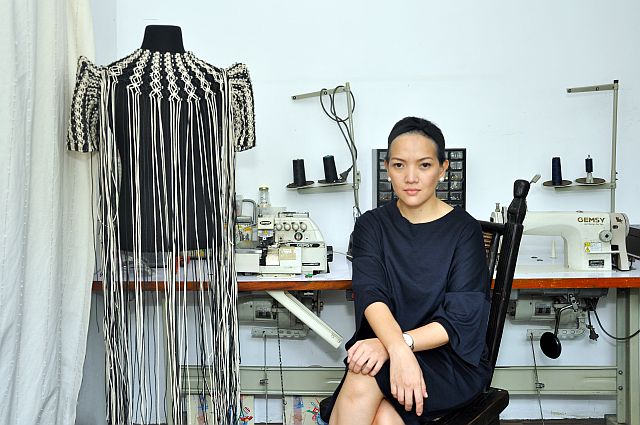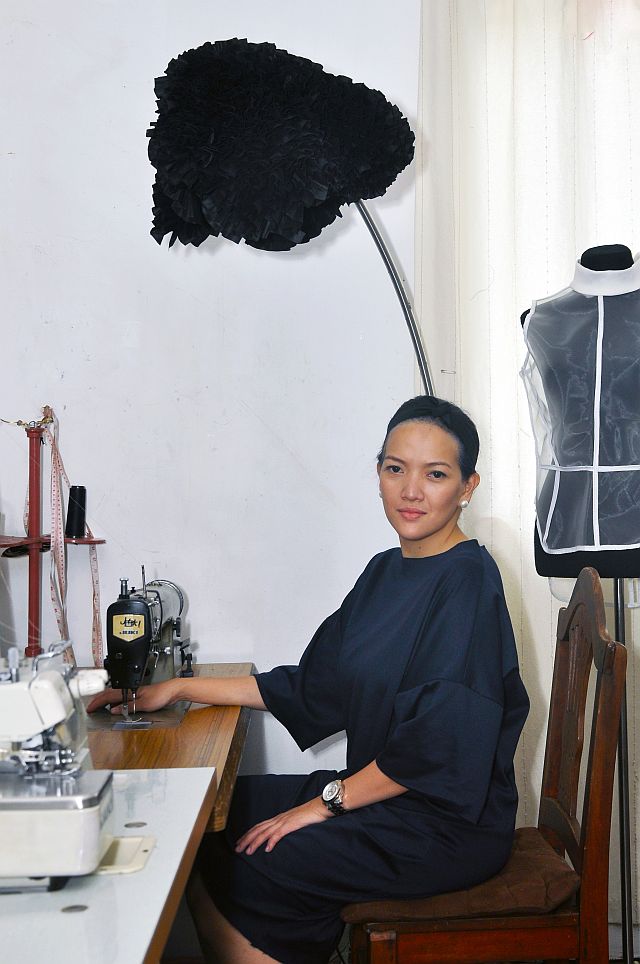
(CDN PHOTO/XAVIER SOLIS)
IF THE humor about designers accepting all materials, including tin roofs, to sew into garments to keep their finances afloat were feasible, then Jul Oliva would have brighter ideas tucked in place.
A step ahead, a league of her own, eureka moment, whatever.
“Comfort destroys being useful,” she says, pointing out that the crux of her creations was fueled with the ache to survive.
True, she’s gifted, but her own origin theory sits pretty in the metamorphosis. She has the hand skills she first discovered at a young age — braiding her hair, braiding her classmates’ hair.
Next, she has the eye for it. “After school, I always passed by the market, and I was fascinated with the materials I saw,” Jul recalls the elementary years at St. Joseph’s Academy in front of the Mandaue City Public Market.
Picnic baskets fluttering above a kiosk of general merchandise and rubber slippers shabbily bundled are in photographs stored in her laptop, collaged like a corporate presentation, to host a visual translation of her own version of those afternoon strolls.
Then, there’s the power of the mind. With an imagination as powerful as the capacity to thwart compositions in interdisciplinary methodology, it could be a little more confusing to tame its wildness. “I cannot concentrate
because I get distracted easily,” she timidly smirks. Say, she’d pause in the middle of a task to respond to a spur-
of-the-moment demand that requires her to focus on a
different grind.
This is the orthodox of her art, an aberration. And that is not necessarily evil. In fact, she has long been in her best stance as a fashion designer running an eponymous line, a fine arts instructor at the University of San Carlos and a material manipulator at the furniture factory of world-renowned industrial designer Kenneth Cobonpue.
“I studied civil engineering first — kay ganahan akong mama — and dropped it after five years. I could not take it anymore,” she remembers. She began with no clear blueprint of her intentions, but in the heart of hearts, she knew all along. Like a diamond in the rough, Jul just needed the ignition, the spark to set everything blazing.
What did you do after you quit college?
When I dropped the course, I flew to America as escort to my sister who had a job offer there. And she was afraid because it was a bigger city. I knew it was going to be a quick trip, and I’d just go back home. But when we arrived in the US, she did not have a job although everything was already laid out for her. It didn’t push through. What am I going to do to survive? So I decided to sew clothes for our neighbors and custom-made designs for them. I sewed everything, including blazers, curtains and sofa covers. It financed us for a year before I came back to Cebu.
You were born with a creative eye. How did get acquainted with its technical aspect?
I really wanted to sew, but I did not know patternmaking back then, especially if it requires tailoring. So I went to Salvation Army to observe how their jackets were made. I dismantled them and studied the procedure. I would finish one set of garments in a day, but I never told clients I could finish it in one day because I did not want to be pressured.

(CDN PHOTO/XAVIER SOLIS)
Tell us about a childhood memory that made you an artist.
My mother is the artist in the family. She likes the microphone; she likes to perform in front of guests. When we were kids, every Sunday, we sang nursery rhymes and she recorded it. My mother scolded me for being too shy. Apart from that, she would train us to call and inquire at business establishments. She always told us that we would learn nothing if we’re too shy. Our family has always been into theater.
How do you express yourself?
I like to experiment with my hair. I’ve tried kinky hair, colored hair, a shaved head.
What is your concept of creativity?
The meaning of creativity is making something out of nothing. I want to do something new and out of the norm. I used to make my own things back in high school. We came to a point that my family had nothing, so I sold bags when I was 15 years old. It all started there. I only had 15 pesos, and the fabric was sold
at 30 pesos. I bought half and sewed the first bag by hand and retailed it at 60 pesos. I was so delighted because my classmates ordered more. I earned 300 pesos, and I gave it to my elder brother Regal to buy food. This is a true story. My parents were not employed back then. I’m very proud of it. Comfort destroys being useful. I also sold candies and meringue hat I keep in an attaché case.
Where do you seek inspiration?
When I visit a city, I always go to its public market. I am very fascinated with public markets… the colors I see there. I am amazed by how they innovate things — they can come up with many entrepreneurial opportunities out of coconuts, such as ice candy, husks, brooms. I tell Sir Kenneth that I need to go to the wet market. I’d scout for materials and come up with something sophisticated for the brand.
How did you meet Kenneth Cobonpue?
I attended a seminar workshop on design, where students were not invited. I just asked the organizers at the University of San Carlos for admission because I was curious and interested. Although I sat at the back, the German facilitators would pass
by and positively remarked on the chair that I was designing, tripod type. We had a small contest among participants. When my turn to explain came, I told them that my inspiration is a
dinosaur. My design won. I did not know Kenneth Cobonpue was among them, and his secretary handed me his card in case I’d be interested to work for him. I never cared about publicity or famous personalities.
How do you look at failures now?
In the beginning, I did not like furniture. Never, never, never — because I did not have any idea about it. I wanted to become a fashion designer and an interior designer. But the organizers
offered me a full scholarship in Germany after I finished my thesis in design school in Cebu. It was about designing the interior of a ship because I did not want it to be a house. But I failed despite the preparations I did; all my classmates were predicting that I’d get the best in thesis title. But failure taught me everything.
What is your state of mind?
Inspiration is everywhere. My brain is full of inspiration, and sometimes, I cannot contain it.
How is it to work with Kenneth Cobonpue?
At Kenneth Cobonpue, I feel like it’s my playground, serious play. I manipulate fabrics or other materials. On my first day, he asked for my portfolio, and I said I did not have one. He asked if I knew AutoCAD, and I said no. I do not like computers. I do not know Excel. I can’t be an illustrator. However, I showed him my toys that I have tinkered from various materials. He said he was impressed because it was what they were doing in his factory. I felt like the workplace was the extension of my room. Usually, I worked with wires because these are what I constantly see in the market. What makes me stay? I have the dedication for this company. It has become my family. I am hurt if someone comes in the company for portfolio only. I know the smell of devotion to design.

(CDN PHOTO/ XAVIER SOLIS)
What’s the greatest lesson you learned from designing both garments and furniture?
As designer, it is always ideal to stay on top. But for me, there’s nothing on top. Everything is just the same. But the process of pursuing excellence would teach you humility and
endurance. Sometimes, I get tired. But you know, if it isn’t tiresome or strenuous, I’d become boastful. If the company or life spoils us, I might be arrogant. So I am thankful for
difficulties.
What is your projection of the local fashion landscape?
What I see among fashion students in the Philippines is that they seek too much attention with the clothes they wear. They do not understand yet. I pity that. It’s only about showmanship. These days, some designers like the entitlement that comes with the title. But design is a service. It needs maturity. But I’m very optimistic about Philippine fashion. I’m happy to see that designers now are really creative and are heading to the international arena.

